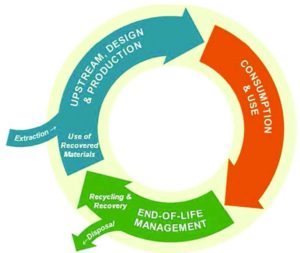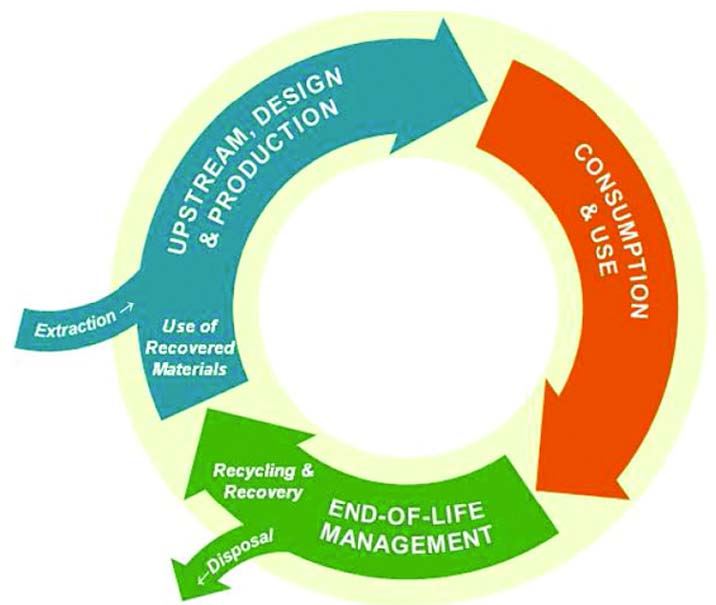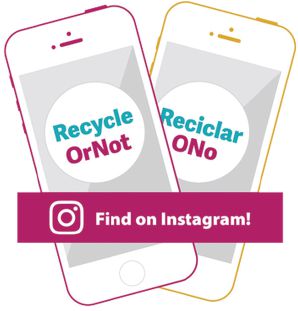The Future of Recycling
What does the future hold for recycling? Two words: zero waste. Or to be more explicit, the future of recycling will be a closed loop system where all discarded materials become resources for others to use. The growing population and the rising standard of living around the world will continue to put increasing demand on the finite resources of our planet. Zero waste is a goal that we must achieve.
According to the Oregon Department of Environmental Quality (DEQ), Oregon recycled 52.3% of its municipal post-consumer (residential and commercial) waste in 2011. This means that we are just a little over halfway to zero waste (or 100% recycled), and that there are some major technological, financial, and cultural hurdles that we must get over before we get there.
But is a zero waste society actually possible, and if it is, how do we get there? Since Mother Nature has operated on a zero waste basis for billions of years, surely humans can as well, but as to how, well now there’s the rub.
“We do so much to prepare our children for the future, but are we doing enough to prepare the future for our children?”– Larry Chalfan – Advisor and Founding Executive Director, Zero Waste Alliance
As various groups, agencies, and businesses study the challenge, one conclusion becomes clear: relying solely on the recycling of our discards will not lead us to zero waste, but it is a good start. If we are going to be successful in eliminating waste we will have to expand well beyond today’s recycling systems by incorporating “reduce” and “reuse” into the process.
A new paradigm is needed. One in which the entire lifecycles of all the products we consume are designed and managed to eliminate waste.
The vision for just such a paradigm can be found in several places, one of which is in the Oregon DEQ document:
 Materials Management in Oregon: 2050 Vision and Framework for Action. The new paradigm is based on the key words “materials management”. The following statement, along with the illustration from the DEQ report, help to describe materials management:
Materials Management in Oregon: 2050 Vision and Framework for Action. The new paradigm is based on the key words “materials management”. The following statement, along with the illustration from the DEQ report, help to describe materials management:
“The materials management approach includes waste prevention and discard management, while seeking to reduce environmental impacts by managing materials through all stages of their life. It identifies impacts and actions to address those impacts across the full cycle of materials and products as they move through the economy, from raw material extraction to product design and manufacture, transport, consumption, use, reuse, recycling and disposal.”
The Oregon DEQ Vision 2050 can be downloaded here: https://www.oregon.gov/deq/mm/Pages/2050-Vision-Workgroup.aspx Oregon is not alone in its pursuit of materials management and its development of a zero waste vision for the year 2050. In 2010, The World Business Council for Sustanable Development (WBCSD) released their report, Vision 2050: The New Agenda for Business.
It was developed over 18 months through a collaborative effort between 29 global companies working with hundreds of representatives from business, government, and civil society, with regional partners and with experts. This is a global vision for a sustainable world in 2050 that looks at far more than just materials management.
The following statement sums up how they perceive materials management in 2050:
“Material demand, consumption and production have been transformed to match the limits of non-renewable resources. Closed-loop recycling, making the concept of waste obsolete, is normal business practice, and societies have a circular approach to resources. Used products and materials, including wood, can be re-engineered to function again for multiple and distinct purposes, or reduced to raw materials for manufacturing other products.”
Here are some examples of what they see for 2050:
- There are no landfills. In fact, they foresee that the mining of materials from the long-closed landfills will be an emerging business.
- People will need to limit their use of non-renewable materials to five metric tons (2024 pounds in a metric ton) per year. To put that into perspective, in the U.S., in 2009, the average person used 85 metric tons per year.
- All waste will be inventoried and stored so it can be recycled later, when technology and/or market conditions make it feasible.
Companies large and small are also developing their own visions for materials management, and incorporating changes in their operations that will move them towards their visions. A March 14, 2012 US Department of Energy Power Point presentation by Jane Powers highlights the results that a few companies have achieved :
General Motor’s first U.S. facility achieved landfill-free status in 2005, and by the end of 2011, more than half of all their world-wide manufacturing facilities had become zero waste to landfill.
Proctor & Gamble’s first manufacturing facility in the U.S. achieved zero waste in December 2010.
As of July 2011, 10 of 14 Honda manufacturing plants in North America had zero waste to landfill. The remaining four are “virtually zero”. In 2001 Honda sent 62.8 pounds of waste to the landfill for each car produced. In 2012 they sent only 1.8 pounds to the landfill for each car produced.
The vision is clear, and as more and more people, companies, communities, and public agencies commit themselves to it, their concept of waste changes. It is no longer waste, it is now a commodity with value, and as such, how it is collected and processed is changing. The focus is on developing strategies and innovations that will recover the highest possible value from the waste stream. The most promising of these include:
- Making it easier for people to recycle by reducing the amount of sorting that they have to do. Communities that have gone to a single curbside container for all fo their recycling have seen an increase in the amount that people recycle. In their 2012 Sustainability Report, Waste Management Inc. reports that single stream recycling increases the recyclable materials collected by 50%
- Improving the sorting technology that is used at the MRFs in order to capture additional material with market value from the waste stream while maintaining the quality of the sorted materials. According to the experts in the collection and recycling business such as Waste Management Inc., the trash that is presently going into landfills still contains billions of dollars worth of recyclable material that could be profitably recovered. This requires investing in new equipment and employee training, so each new level of improvement has to remain in operation long enough to recoup that investment.
- Creating innovative ways to handle items that are hard to recycle such as compact fluorescent lamps (CFL), cell phones, computers, batteries, and medical waste. An example of this is Waste Management’s Think Green from Home program, which uses special mail-in kits that enable consumers to send in their CFLs, batteries, small electronics, syringes, and lancets from home.
- Driving more responsibility for improving recycling upstream to the manufacturer who can redesign products to use fewer harmful substances, to be more durable, reuseable and recyclable, and to make products from recycled materials. The emerging science of biomimicry holds great promise for developing new manufacturing processes that will have fewer environmental impacts and for creating products that are easier to recycle.
- Expanding the pilot facilities that are using a variety of emerging technologies for processing the post recycling waste material into fuels, chemicals, and energy. Agilyx in Beaverton and Inentec in Bend, are examples of the companies that are working in this area.
- Changing consumer behavior with regulations. Oregon has had a bottle bill since 1971, and Portland recently started collecting trash every other week along with the curbside recycling of food waste for composting.
The journey from “garbage” to “recycling” to “waste management” to “materials management” to “zero waste” is well underway. So what can you and I do to help?
1) Make mindful decisions when we purchase products:
- Does it contain recycled material?
- Is it easily recycled at the end of its life.
- Is the packaging easily recycled?
- Will a repurposed or used item serve me just as well?
2) Am I getting the best buy from the standpoint of durability? Support the companies, institutions and organizations that are pursuing the zero waste vision.
3) Reuse and repurpose items that we already have.
4) Reduce our purchases of items that are difficult or impossible to recycle.
If we all stay committed to the vision, we can make it happen!
Third in a series of articles “Mysteries of Recycling” published in the Green Living Journal. Read (Part 1 Understanding the Problem, Part 2 The business of recycling) A special thanks to Michelle Metzler, the Recycling and Composting Coordinator for Waste Management of Oregon, for sharing her time, knowledge, and suggestions with us.






